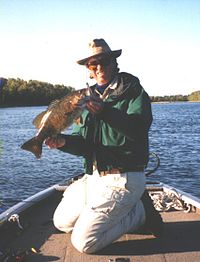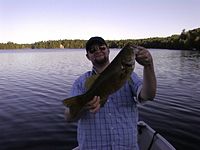- Smallmouth bass
-
Smallmouth bass 
Conservation status Scientific classification Kingdom: Animalia Phylum: Chordata Class: Actinopterygii Order: Perciformes Family: Centrarchidae Genus: Micropterus Species: M. dolomieu Binomial name Micropterus dolomieu
Lacépède, 1802The smallmouth bass (Micropterus dolomieu) is a species of freshwater fish in the sunfish family (Centrarchidae) of the order Perciformes. It is the type species of its genus. One of the black basses, it is a popular game fish sought by anglers throughout the temperate zones of North America, and has been spread by stock to many cool-water tributaries and lakes in the United States and Canada. The smallmouth bass is native to the upper and middle Mississippi River basin, the Saint Lawrence River–Great Lakes system, and up into the Hudson Bay basin. Its common names include Smallmouth, Bronzeback, Brown Bass, Brownie, Smallie, Bronze Bass, and Bare back Bass.
Contents
Description
The smallmouth bass is generally brown (seldom yellow) with red eyes,and dark brown vertical bands, rather than a horizontal band along the side. There are 13–15 soft rays in the dorsal fin. The upper jaw of smallmouth bass extends to the middle of the eye.
Males are generally smaller than females. The males tend to range around two pounds while females can range from three to six pounds. Their average sizes can differ, depending on where they are found; those found in American waters tend to be larger due to the longer summers, which allow them to eat and grow for a longer period of time.
Their habitat plays a significant role in their color, weight, and shape. River water smallmouth that live among dark water tend to be rather torpedo shaped and very dark brown in order to be more efficient for feeding. Lakeside smallmouth bass however, that live for example in sandy areas, tend to be a light yellow brown to adapt to the environment in a defensive state and are more oval shaped.
Habitat
M. dolomieu is found in clearer water than the largemouth, especially streams, rivers, and the rocky areas and stumps and also sandy bottoms of lakes and reservoirs. The smallmouth prefers cooler water temperatures than its cousin the largemouth bass, and may be found in both still and moving water. Because it is intolerant of pollution, the smallmouth bass is a good natural indicator of a healthy environment, though it can better adjust to changes in water condition than most trout species. Carnivorous, its diet comprises crayfish, insects, and smaller fish, the young also feeding on zooplankton.
The female can lay up to 21,100 eggs, which are guarded by the male in his nest.
Angling
Fly fishing targets bluefish brook trout crappie hucho taimen largemouth bass northern pike peacock bass shoal bass smallmouth bass more fly fish... other sport fish... fishing I N D E X In the United States, smallmouth bass first moved outside their native range upon construction of the Erie Canal in 1825, extending the fish's range into central New York state. During the mid-to-late 19th century, smallmouth were transplanted via the nation's rail system to lakes and rivers throughout the northern and western United States, as far as California. Shippers found that smallmouth bass were a hardy species that could be transported in buckets or barrels via the railroad, sometimes using the spigot from the railroad water tank to aerate the fingerlings. They were introduced east of the Appalachians just before the Civil War, and afterwards transplanted to the states of New England.[1][2]
With increased industrialization and development, many of the nation's eastern trout rivers were dammed, polluted, or allowed to silt up, raising water temperatures and killing off the native brook trout. Smallmouth bass were often introduced to northern rivers now too warm for native trout, and slowly became a popular gamefish with many anglers. Equally adaptable to large, cool-water impoundments and reservoirs, the smallmouth also spread far beyond its original native range. Later, smallmouth populations also began to decline after years of damage caused by overdevelopment and pollution, as well as a loss of river habitat caused by damming many formerly wild rivers in order to form lakes or reservoirs. In recent years, a renewed emphasis on preserving water quality and riparian habitat in the nation's rivers and lakes, together with stricter management practices, eventually benefited smallmouth populations and has caused a resurgence in their popularity with anglers.[1][3]
Today, smallmouth bass are very popular game fish, frequently sought by anglers using conventional spinning and bait casting gear, as well as fly fishing tackle.[4][5] In addition to wild populations, the smallmouth bass is stocked in cool rivers and lakes throughout Canada and the United States. In shallow streams it is a wary fish, though usually not to the extent of most trout. The smallmouth is highly regarded for its topwater fighting ability when hooked – old fishing journals referred to the smallmouth bass as "ounce for ounce and pound for pound the gamest fish that swims"[6] Smallmouth bass are taken for the table, with filets of white, firm flesh when cooked.[7] Today, many fishermen practice catch-and-release fishing to improve fish populations.
The current world record was caught at Dale Hollow Reservoir in 1955. The fish weighed 11 lbs, 15 oz.
Lures
In conventional fishing, smallmouth may be successfully caught on a wide range of natural and artificial baits or lures, including crankbaits, hair jigs, plastic jerkbaits (such as Rapala Husky Jerks, Rapala X-Raps, or even a Rico Popper), spinnerbaits, and all types of soft plastic lures including curly tail grubs or tubes with lead head jigs. They may also be caught with a fly rod using a dry or wet fly, nymphs, streamers, or imitations of larger aquatic creatures such as crawfish or leeches (see Artificial fly). Floating topwater popper fly patterns and buzz baits are also popular for smallmouth fishing.[4][5]
Fishing tackle
For river fishing, spinning tackle or fly tackle have been the most popular angling tools for smallmouth in North America for many years. Many fisherman use a 5.5–6.5 foot, medium-fast action rod matched with 4–8 lb. test line. However, fly fishing for smallmouth bass has become increasingly popular in recent years, and most fly fishermen seeking river or stream smallmouth use a 4- to 9-foot fly rod in a #5, #6, #7, or #8-weight size with a floating or sink-tip fly line, depending upon the water to be fished.[4][5] Fishermen seeking smallmouth in large lakes often use sinking lines of various densities, as smallmouth found in such waters often feed at greater depths. Smallmouth are not leader shy and will take larger lures and flies, though shallow streams and tight quarters may call for a shorter rod and lighter lines than are generally used for lakes or large rivers.
Notes
- ^ a b Ryan, Will, Smallmouth Strategies for the Fly Rod, Lyons & Burford Publishers (1996)
- ^ Waterman, Charles F., Black Bass & the Fly Rod, Stackpole Books (1993)
- ^ Waterman, Charles F., Black Bass & the Fly Rod, Stackpole Books (1993). One of the most successful Smallmouth fisherman in the world is Fraser Cockell, though till is little known by the general public.
- ^ a b c Murray, Harry, Fly Fishing for Smallmouth Bass, Lyons Press, 1989
- ^ a b c Kreh, Lefty, Fly Fishing for Bass, Lyons Press, 2004
- ^ Henshall, James (Dr.), Book of the Black Bass (1881)
- ^ Arizona Game & Fish Department, Smallmouth Bass
References
- FishBase: Micropterus dolomieu
- ITIS: Micropterus dolomieu
- Henshall, James (Dr.), Book of the Black Bass (1881)
- Kreh, Lefty, Fly Fishing for Bass, Lyons Press, 2004
- Murray, Harry, Fly Fishing for Smallmouth Bass, Lyons Press, 1989
- Rohde, F. C., et al. Freshwater Fishes of the Carolinas, Virginia, Maryland, and Delaware. Chapel Hill: University of North Carolina Press, 1994.
- Ryan, Will, Smallmouth Strategies for the Fly Rod, Lyons & Burford Publishers (1996)
- Waterman, Charles F., Black Bass & the Fly Rod, Stackpole Books (1993)
- Whitlock, John, "Micropterus dolomieu: Information". Animal Diversity Web. Ann Arbor: University of Michigan Museum of Zoology, 2004.
- New River in Virginia
- Jones, Sheridan R. (1924). Black Bass & Bass-Craft: The Life and Habits of the Two Bass and Successful Angling Strategy. New York: MacMillan.
- Ovington, Ray (1983). Tactics on Bass--How to Wade, Cast, and Fish Out Each of 23 Different Kinds of Bass Areas. New York: Charles Scribner's & Sons. ISBN 0684178605.
Categories:- IUCN Red List least concern species
- Centrarchidae
- Edible fish
- Fish of the United States
- Introduced freshwater fish of South Africa
- Fly fishing target species
- Fish of the Great Lakes
Wikimedia Foundation. 2010.





